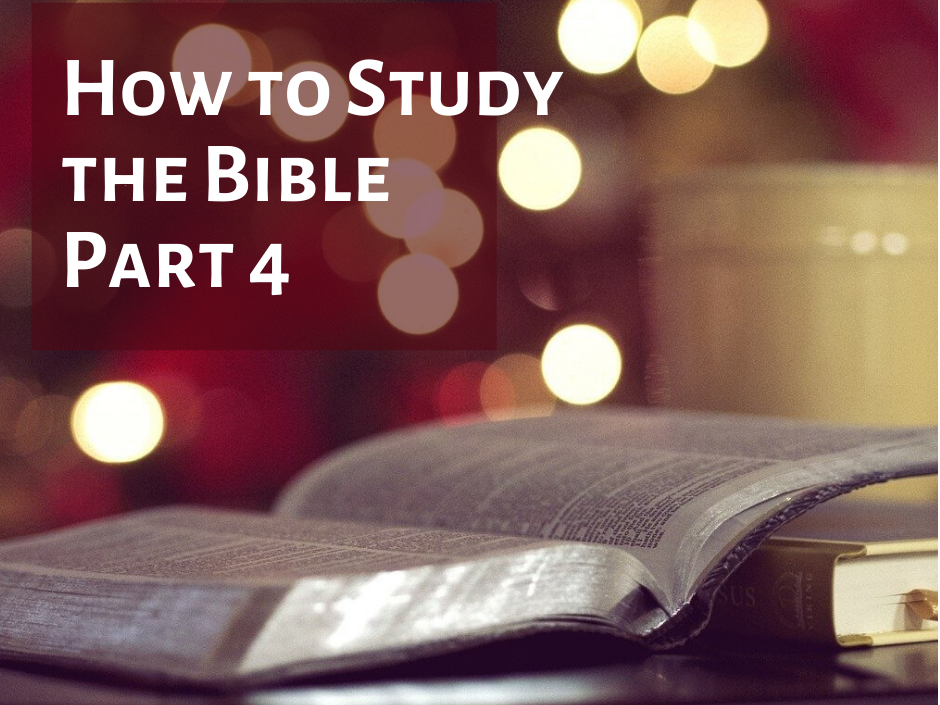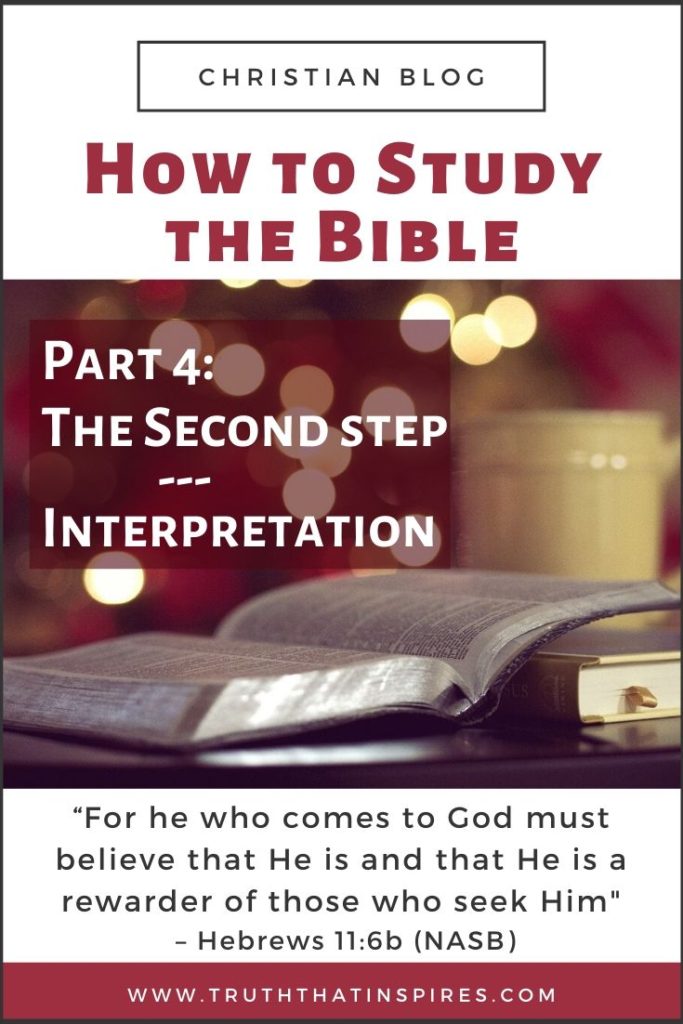
How to Study the Bible – Part 4
Below are links to the previous articles in this series in case you missed them:
Part 1 – Is Studying God’s Word Worth My Time?
Part 2 – Three Steps of Bible Study
Part 3 – The First Step: Observation
This article will take a closer look at the second step of bible study which is Interpretation. Remember, don’t skip the previous step! Time spent in Observation is crucial to accurate interpretation and full understanding of scripture.
In Part 2, I likened the step of Interpretation to sorting the pieces of a puzzle and putting the outside framework together. This step correlates the information learned during Observation and consults additional resources until the big picture is understood. It is the quest for the meaning of the passage being studied, keep that in mind as you work through each step.
As always, start with prayer. Ask God to guide you to the correct interpretation. Ask that He open your eyes to the truth that He wishes to reveal to you and to prepare your heart to receive and understand that truth.
When thinking about interpreting scripture it can be easy to worry about our own inadequacies and getting it wrong. But the hope of success does not rely on us but in God’s willingness to make Himself known to those who seek Him (Hebrews 11:6). We are inadequate, but God is not!
Ready to dive in? After you have sought God’s guidance look at all of the information you gathered previously and consider it in light of these four steps: Context, Comparison, Culture/Customs, and Consultation.
Context
It is important to consider the context of the passage you are studying. The context is simply the setting in which the scripture is written. Taking scripture out of context opens the door for heresy and incorrect application. The context of the passage provides the basis for the passage.
To determine the context of a passage you must look beyond the passage itself. It is important to read what comes before and after the verses being studied to determine where this passage fits in and what role it plays in the bigger picture.
For example, if studying Jesus calming the sea in Mark 4:35-41 you will discover that event is the first of a series of four miracles. It is one the disciples experienced first-hand for themselves. Each of the four miracles present a different aspect of faith. Knowing the context reveals that this passage is teaching about faith.
Knowing who wrote the passage and who his audience was, also provides context to understanding the passage. For example, most biblical scholars believe King Solomon wrote the book of Ecclesiastes. They also believe his audience was the present-day Hebrews of the nation of Israel. It is believed he wrote Ecclesiastes right after the completion of the Temple, the most extravagant and costly building in the known world. The book teaches not to waste your life in search of such things as riches, sexual pleasures and power, but to seek and serve the Creator of all things. The only person qualified to write such wisdom would be the richest and most powerful man on earth, King Solomon himself. Knowing the context of Ecclesiastes helps the reader understand the purpose of its content.

Comparison
Compare how different versions of the Bible translate the same passage. When there are differences which seem to conflict with each other, consult the original Greek or Hebrew using an Interlinear.
Looking at different translations of Romans 12:1-2 you will see that what NASB translates as “so that you may prove” is translated in other versions as:
- then you will be able to test and approve (NIV)
- that by testing you may discern (ESV)
- so that you may discern (HCSB)
Seeing these different translations helps to comprehend the concept of what it means to “prove” what the will of God is.
Consider the answers you previously discovered when you asked the “what” questions. For stories that are told by different authors, compare and contrast how each author relays the information. Remember once again to keep in mind who the author is, what perspective they are coming from, and who the author’s audience is. Often, subtle differences in how a particular story is expressed stems from the answers to these questions.
Look for phrases or keywords that are used in other places in the Bible and what you can learn from that additional context. A Concordance is very helpful for this step.
Culture/Customs
Consult other resources such as a Bible Dictionary to understand the cultural context of the passage. Answers to some of the “where” questions you previously asked will guide you in this step. Understanding the culture of the time will reveal both “how” and “why” certain actions are performed.
Use a Bible Atlas to trace journeys and see what the geography of the region was like. Were there mountains, valleys, or rivers that had to be crossed? Was it dry desert where food supplies had to be carried with them or were there lush green lands where they could grow crops and nourish their flocks? Consider how the answers to those questions help to frame the interpretation of the information you learned during your previous observations.
If the passage mentions festivals being celebrated, research to understand why that celebration was occurring and how they celebrated it.
Look at pictures of structures, clothing, utensils, etc. from that time period. This helps add to the understanding and appreciation of the culture. All this information helps you to understand what each of the pieces of the puzzle mean and how they fit together.
Consultation
As a last step, read commentaries on the passage to see other’s understanding. I stress to make this the last step in Interpretation after you have gathered and exhausted asking questions and seeking answers to those questions for yourself. When reading commentaries always consider, does this align with what I have read in the bible for myself? Commentaries can provide additional insights and should spurn you to further study in a particular area that was not revealed to you directly. Be alert for false doctrines and inaccurate interpretations. Look for commentaries that are endorsed by sources you know to be theologically sound.
Also, consult with others you know personally. Discuss scripture over coffee or lunch, once again weighing input you receive against what you know as God’s truth. I like to work puzzles with other people. It’s nice to spend that time in an activity where you can chat and visit while you complete the project. They also bring a different perspective to the table. I can have been looking for a piece for hours and someone else walk up with fresh eyes and immediately see what I couldn’t.
Having someone else’s perspective after you have completed your own search has value, both when working a jigsaw puzzle and when studying Gods Word.
Summary
The second step in bible study is to determine the meaning of the passage. It is looking beyond the passage itself at the context to determine where this passage fits in and what part it plays in the bigger picture. It is comparing the passage being studied to other passages on the same topic and also looking at different translations of the same passage. It is looking at the culture and customs at the time in which the passage occurs and finally consulting what others have to say.
Consult a bible dictionary, atlas, interlinears, concordance, and commentaries. These are all good resources to help understand what all the pieces of the puzzle mean. Write down any unanswered questions that you have. God will reveal them to you in His perfect timing.
It might seem like you are done at this point but please don’t stop here! Now you can get down to work completing the puzzle and doing something with what you have learned! We’ll look closer in the next article at applying the interpretation that God has revealed.
Save this Pin for Later! Sharing is Caring!

I recently completed my first on-line Bible course from Dallas Theological Seminary. Some of the material in this series is taken from what I learned in that course. Some of the material comes from teaching David received when he attended New Orleans Baptist Theological Seminary and some of it is from my own experiences of over a half-century on this planet attending church, praying, studying and seeking God’s will. Wow, that really makes me sound old!
Have you signed up for our email list? If you give us your email address, we’ll make sure you never miss a post and are kept up to date on all the latest resources that we offer (average of only one to two emails/week). You can also choose to read through the Bible in one year with us. We'll send you the reading assignment each week with a snippet highlight (average of one email/week). We promise that we will not sell your information and you can be removed from the list at any time by clicking the unsubscribe link at the bottom of each of our emails. See our Privacy Policy for more details.
Below are the latest offers from our Affiliate Partners. Please click the links and visit their sites.
They have lots of products at great prices. We may make a small commission if you purchase through these links which help keep this website up and running and the best part is... there is no extra cost to you! Read our Disclosure for more information. For more details on each affiliate see our "Shop" page.
